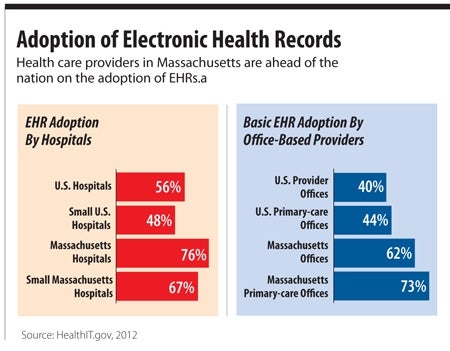A doctor gets a message from a patient, including a photo of a rash, diagnoses the problem and writes a prescription — all from his smartphone while he sits at a restaurant table. A patient pulls up her doctor’s schedule on her iPad, scans through the available times, and books an appointment in seconds. A pediatrician makes a note of a child’s symptoms and receives an immediate, automatic alert noting similarities to a new viral infection that other providers in the area have diagnosed in recent days.
These kinds of scenarios aren’t just a hopeful vision of the future of health care. They’re happening right now, or are planned within months, here in Central Massachusetts. As they enter their 2014 fiscal year, which began in October, local hospitals and doctors’ offices are working through the nitty-gritty details of complying with new federal guidelines for electronic health records and related technology. But they’re also beginning to reap the rewards of their technology investments in greater convenience for them and their patients, with better health outcomes.
Worcester-based Reliant Medical Group is a leader when it comes to the use of electronic systems. Patients can use an online portal called MyChart to access parts of their medical records, schedule appointments and ask for prescription renewals, either through their computer or via a smartphone app. Patients using blood pressure monitors can also securely transmit their numbers into their health records, and anyone overdue for a particular test may receive an alert through the system.
“We spend a lot of time on those and that makes a huge difference,” said Dr. Lawrence Garber, medical director for informatics at Reliant.
Harold Lemieux, chief information officer at Harrington HealthCare System in Southbridge, said Harrington Memorial Hospital was an early adopter of electronic records. It qualified for federal funding to support the systems in 2011 — the first year it was offered — by demonstrating it had reached the first stage of “meaningful use” of electronic records. In 2014, it plans to again be on the forefront of meaningful use stage 2. Among other things, that involves being able to share patient data with other health systems.
“Stage 2 certainly imposes a lot of the systems and technology requirements that will set the compliant hospitals up to be able to connect to those exchanges,” Lemieux said.
Help From Mass. HIway
He said that, while Massachusetts hospitals are generally leaders in adopting electronic records, they’re actually a bit behind the curve when it comes to exchanging information. But Harrington and other local systems are working to change that, with the help of the Massachusetts Health Information Highway, otherwise known as the HIway.
The HIway is a state initiative that aims to connect health care providers, letting them securely share information on patients. In future phases, it also promises to help providers coordinate patient care and analyze health information to improve quality and cost.
In recent years, Lemieux said, the Harrington system has helped 94 percent of its affiliated doctors’ offices adopt computerized order entry, one of the first steps toward fully electronic records. Medication administration and nursing documentation are also computerized.
Lemieux said it’s been a challenge for providers to adopt the electronic systems, but having the data available is already allowing Harrington to analyze trends involving patients at both the hospital and doctors’ offices, giving it new information about the populations that need special focus.
Within the next six months, Harrington also plans to launch a unified online portal that will give patients access to both doctors’ offices and the hospital, allowing for two-way communication.
“We’re trying to create one-stop shopping for patients,” he said.
See Data, Act On It
Industrywide, providers are gaining more actionable information through data analysis every year, said Heather Caouette, spokeswoman for Westborough-based health software company eClincalWorks.
“What you can do with the population health, ideally, is analyze what has happened and forecast,” she said.
In one case, she said, a study of body- mass index conducted four years ago cost $4 million and involved 1,000 patients. With modern software, it was recently replicated — for free, and with 100,000 patients. And the results were available within 24 hours.
“Now that electronic health records are in place, it’s amazing what it can facilitate,” Caouette said.
At Saint Vincent Hospital in Worcester, CIO Kristin Darby said IT systems can pull in data from multiple systems, allowing providers to identify high-risk situations more quickly. Modern analytics can drive proactive and preventative care, helping stop problems before they start, and they can help ensure that serious problems are identified quickly.
“It allows us to potentially have early detection of high-risk situations that you may not notice as quickly,” she said. “That correlation and proactive analytics allows us to drive behavior in ways that we didn’t have.”
Darby said Saint Vincent’s IT priorities include developing innovative ways to improve care, as well as complying with government demands. She and Lemieux both said a significant amount of resources is going to adjusting the coding used for reporting government reporting on diagnoses and procedures to new code sets, ICD-10.
Darby said the meaningful use guidelines are pushing the hospital toward positive developments, like being able to send records to Tufts Medical Center through the HIway when patients go there for specialty care. (Saint Vincent has a health care network affiliation with Tufts.) But she said trying to adopt all government requirements, while focusing on more specific local priorities, can be a challenge.
“From an IT perspective I would say it’s certainly a resource balance to be able to focus on meaningful use, ICD-10 and then also the innovative technology that you want to have being completed to drive patient improvements,” she said.

